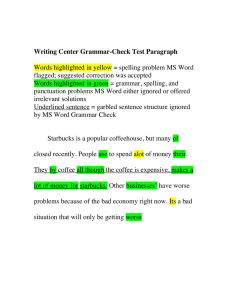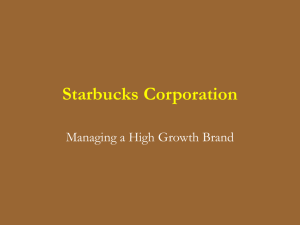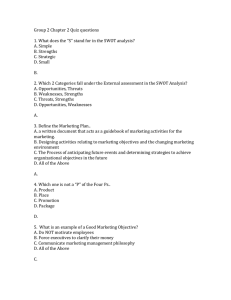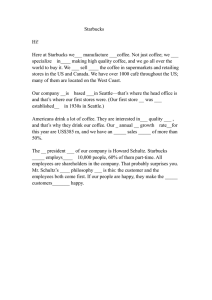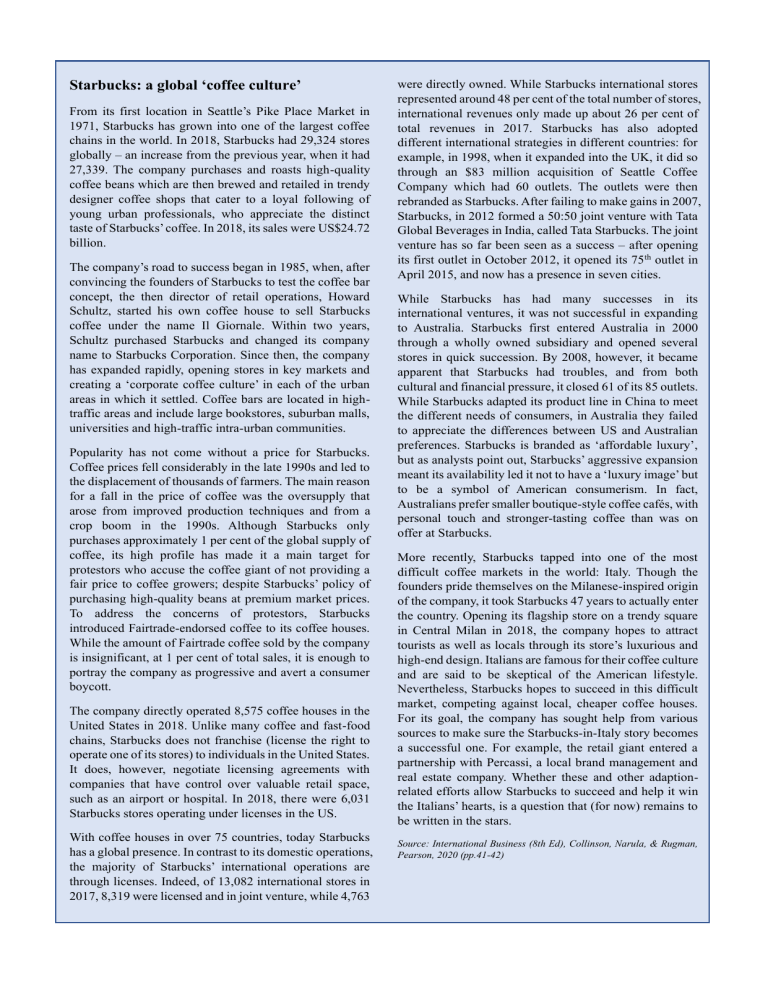
Starbucks: a global ‘coffee culture’ From its first location in Seattle’s Pike Place Market in 1971, Starbucks has grown into one of the largest coffee chains in the world. In 2018, Starbucks had 29,324 stores globally – an increase from the previous year, when it had 27,339. The company purchases and roasts high-quality coffee beans which are then brewed and retailed in trendy designer coffee shops that cater to a loyal following of young urban professionals, who appreciate the distinct taste of Starbucks’ coffee. In 2018, its sales were US$24.72 billion. The company’s road to success began in 1985, when, after convincing the founders of Starbucks to test the coffee bar concept, the then director of retail operations, Howard Schultz, started his own coffee house to sell Starbucks coffee under the name Il Giornale. Within two years, Schultz purchased Starbucks and changed its company name to Starbucks Corporation. Since then, the company has expanded rapidly, opening stores in key markets and creating a ‘corporate coffee culture’ in each of the urban areas in which it settled. Coffee bars are located in hightraffic areas and include large bookstores, suburban malls, universities and high-traffic intra-urban communities. Popularity has not come without a price for Starbucks. Coffee prices fell considerably in the late 1990s and led to the displacement of thousands of farmers. The main reason for a fall in the price of coffee was the oversupply that arose from improved production techniques and from a crop boom in the 1990s. Although Starbucks only purchases approximately 1 per cent of the global supply of coffee, its high profile has made it a main target for protestors who accuse the coffee giant of not providing a fair price to coffee growers; despite Starbucks’ policy of purchasing high-quality beans at premium market prices. To address the concerns of protestors, Starbucks introduced Fairtrade-endorsed coffee to its coffee houses. While the amount of Fairtrade coffee sold by the company is insignificant, at 1 per cent of total sales, it is enough to portray the company as progressive and avert a consumer boycott. The company directly operated 8,575 coffee houses in the United States in 2018. Unlike many coffee and fast-food chains, Starbucks does not franchise (license the right to operate one of its stores) to individuals in the United States. It does, however, negotiate licensing agreements with companies that have control over valuable retail space, such as an airport or hospital. In 2018, there were 6,031 Starbucks stores operating under licenses in the US. With coffee houses in over 75 countries, today Starbucks has a global presence. In contrast to its domestic operations, the majority of Starbucks’ international operations are through licenses. Indeed, of 13,082 international stores in 2017, 8,319 were licensed and in joint venture, while 4,763 were directly owned. While Starbucks international stores represented around 48 per cent of the total number of stores, international revenues only made up about 26 per cent of total revenues in 2017. Starbucks has also adopted different international strategies in different countries: for example, in 1998, when it expanded into the UK, it did so through an $83 million acquisition of Seattle Coffee Company which had 60 outlets. The outlets were then rebranded as Starbucks. After failing to make gains in 2007, Starbucks, in 2012 formed a 50:50 joint venture with Tata Global Beverages in India, called Tata Starbucks. The joint venture has so far been seen as a success – after opening its first outlet in October 2012, it opened its 75 th outlet in April 2015, and now has a presence in seven cities. While Starbucks has had many successes in its international ventures, it was not successful in expanding to Australia. Starbucks first entered Australia in 2000 through a wholly owned subsidiary and opened several stores in quick succession. By 2008, however, it became apparent that Starbucks had troubles, and from both cultural and financial pressure, it closed 61 of its 85 outlets. While Starbucks adapted its product line in China to meet the different needs of consumers, in Australia they failed to appreciate the differences between US and Australian preferences. Starbucks is branded as ‘affordable luxury’, but as analysts point out, Starbucks’ aggressive expansion meant its availability led it not to have a ‘luxury image’ but to be a symbol of American consumerism. In fact, Australians prefer smaller boutique-style coffee cafés, with personal touch and stronger-tasting coffee than was on offer at Starbucks. More recently, Starbucks tapped into one of the most difficult coffee markets in the world: Italy. Though the founders pride themselves on the Milanese-inspired origin of the company, it took Starbucks 47 years to actually enter the country. Opening its flagship store on a trendy square in Central Milan in 2018, the company hopes to attract tourists as well as locals through its store’s luxurious and high-end design. Italians are famous for their coffee culture and are said to be skeptical of the American lifestyle. Nevertheless, Starbucks hopes to succeed in this difficult market, competing against local, cheaper coffee houses. For its goal, the company has sought help from various sources to make sure the Starbucks-in-Italy story becomes a successful one. For example, the retail giant entered a partnership with Percassi, a local brand management and real estate company. Whether these and other adaptionrelated efforts allow Starbucks to succeed and help it win the Italians’ hearts, is a question that (for now) remains to be written in the stars. Source: International Business (8th Ed), Collinson, Narula, & Rugman, Pearson, 2020 (pp.41-42)


